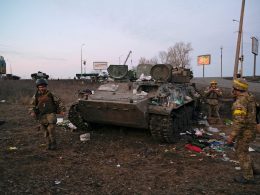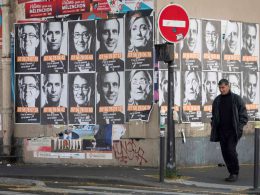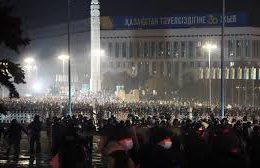A key phase in the Syrian revolution has opened up with the balance of power finely poised between the forces of the state and the opposition movement. It is a testament to the courage and resilience of the protesters that demonstrations continue to sweep Syria, despite the ongoing state repression which has seen an estimated 5,000 demonstrators killed and 30,000 imprisoned.
On 30 December demonstrations grew to more than 250,000 people in the cities of Idlib and Hama, and spread across the country with significant protests in the regimes main powerbases of Aleppo and Damascus. Faced with a deteriorating economic situation, increasing imperialist interference and army defections, the regime is under extreme pressure. There is a question over how long the army can be used effectively as a tool of repression, with the prospect of more soldiers defecting to join the ranks of the “Free Syrian Army” currently defending protestors.
For more than 40 Years, Bashar Assad and his father Hafez have presided over a brutally oppressive dictatorship. The Ba’athist party, a left nationalist force, originally came to power championing ideas of Arab unity, anti-imperialism and state ownership. Indeed, despite the repressive environment, the regime continues to draw upon a significant level of popular support stemming from the past reforms that benefitted certain layers in society. Recent decades however have seen the increasing liberalisation of the economy, hitting living standards for many and making Syria more vulnerable to world economic pressures. As in other Arab states, the protests which ignited ten months ago were fuelled by anger at high unemployment, rising prices and poverty. The situation has deteriorated further since the protests began owing to increased military spending, a collapse in tourism and an estimated 40% decline in economic activity, plunging the economy into deep recession and spurring new waves of protest.
At this time last year, as protests spread across the Arab world inspired by events in Tunisia and Egypt, it appeared mass demonstrations and square occupations would be enough to oust the hated dictatorships. The old regimes however quickly adjusted to the new situation and in Egypt it was only the development of a mass strike wave that eventually brought down Mubarak. In Syria, to cling onto power Assad has combined mass repression, government resignations and reforms, and propaganda predicting a descent into the kind of sectarian conflict that has plagued neighbouring Iraq. In reality, the regime has attempted to use the recent spate of bombings, which they attribute to Islamist groups, to stir sectarian division. Sectarian tensions are high in some areas as a result of the activities of state forces with the key protest city of Homs, described as more like a warzone than a city, becoming increasingly polarised with districts dominated by the Sunni majority more and more segregated from those of the Alawite minority.
Independent workers’ organisation needed
The opposition movement has continued to draw support from all nationalities, ethnicities and religions, however it remains organisationally fragmented. Although the main umbrella groups, the western-allied exiles in the Syrian National Council (SNC) and the National Coordination Committee (NCC) based largely inside Syria, were able to fudge “a roadmap to democracy” agreement on 31 December, huge divisions on key practical questions remain within and between both bodies. These self-appointed leaders however, do not speak for the mass of ordinary protesters on the streets, and it is at a more local level where the initiative remains. In December the opposition’s local coordinating committees (LCCs) organised the “Strike for Dignity”, or “Karameh Strike” involving coordinated strike action by various sections of workers, student civil disobedience and shop closures. This was a significant development, but the relative weakness of the labour movement in Syria and its lack of independence from the regime has up to now proved a significant barrier to independent working class action.
A fear of the regime being brought down by the action of the masses of workers, students and defecting soldiers is a key factor motivating the increasing intervention of the western powers and their allies in the region into the situation. Although the Syrian regime has been a longstanding thorn in the side of western Imperial interests, thus far direct military intervention has been ruled out due to fears the situation could develop into another Iraq style quagmire. Rather, they are attempting to oust Assad and install a pliable regime by other means, utilising economic sanctions and pressure from their allies, Turkey and the Arab League. Their goal is to identify and back a leadership that could be relied upon to serve their interests in a post-Assad Syria, which could be drawn from either the old elite or the opposition.
As of yet however, no significant divisions have opened up within the Syrian elite. In recent speeches and pro-government demonstrations, Assad has rallied his supporters against “the foreign conspiracies” involving the western powers, the Arab states, Islamist groups and the opposition movement. Repression has been stepped up significantly since the much heralded “peace plan” conducted with the Arab league last month.
No faith in capitalism opposition
As the recent experiences in Egypt, Tunisia and Libya demonstrate, workers should have no faith in elements of the old regime or pro-capitalist opposition leaders. An organised strategy of mass demonstrations and general strikes is necessary together with a program that could unite the working class and poor masses behind demands for democratic rights for all minorities, genuine workers democracy and public ownership of the country’s key resources. To counter the brutal repression, workers also need to organise armed, non-sectarian defence bodies in every community and workplace. The formation of Independent trade unions and a new mass workers party are also key to realising the protestors demands for an end to unemployment, poverty and bloodshed in Syria.
- United struggle against the regime by the working class and poor in Syria drawn from all nationalities, ethnicities and religions
- Build democratically run committees in workplaces and communities for defence against repression and to develop the struggle
- No to any interference by the world or regional capitalist powers
- For independent trade unions and a new mass party of working people
- For a revolutionary constituent assembly
- For a democratic, majority workers’ and poor people’s government, with socialist policies, guaranteeing full democratic rights for all minorities












